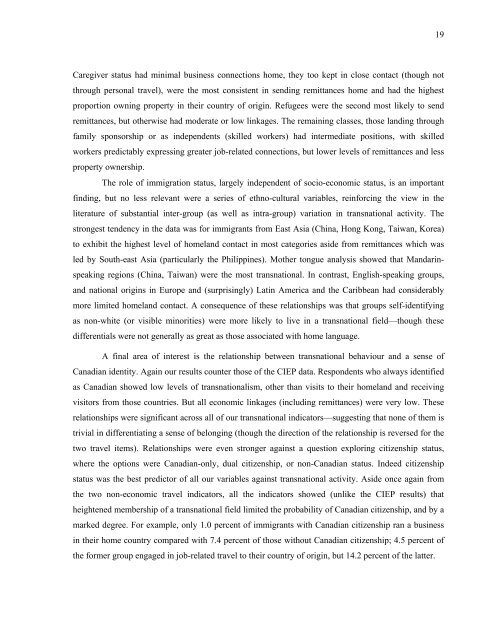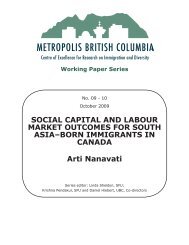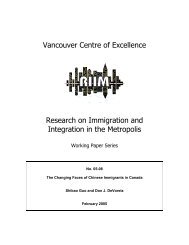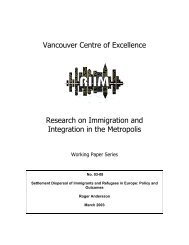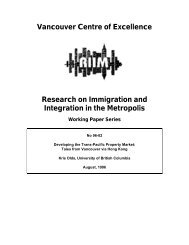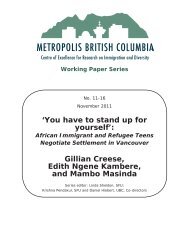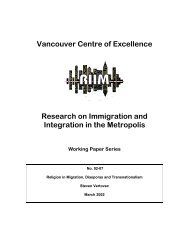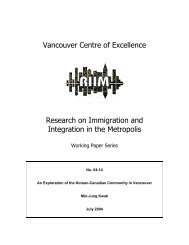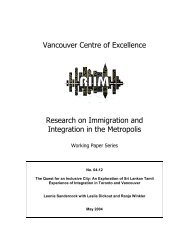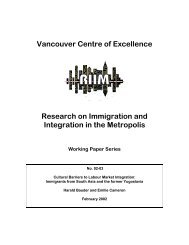Characteristics of Immigrant Transnationalism in ... - Metropolis BC
Characteristics of Immigrant Transnationalism in ... - Metropolis BC
Characteristics of Immigrant Transnationalism in ... - Metropolis BC
Create successful ePaper yourself
Turn your PDF publications into a flip-book with our unique Google optimized e-Paper software.
19<br />
Caregiver status had m<strong>in</strong>imal bus<strong>in</strong>ess connections home, they too kept <strong>in</strong> close contact (though not<br />
through personal travel), were the most consistent <strong>in</strong> send<strong>in</strong>g remittances home and had the highest<br />
proportion own<strong>in</strong>g property <strong>in</strong> their country <strong>of</strong> orig<strong>in</strong>. Refugees were the second most likely to send<br />
remittances, but otherwise had moderate or low l<strong>in</strong>kages. The rema<strong>in</strong><strong>in</strong>g classes, those land<strong>in</strong>g through<br />
family sponsorship or as <strong>in</strong>dependents (skilled workers) had <strong>in</strong>termediate positions, with skilled<br />
workers predictably express<strong>in</strong>g greater job-related connections, but lower levels <strong>of</strong> remittances and less<br />
property ownership.<br />
The role <strong>of</strong> immigration status, largely <strong>in</strong>dependent <strong>of</strong> socio-economic status, is an important<br />
f<strong>in</strong>d<strong>in</strong>g, but no less relevant were a series <strong>of</strong> ethno-cultural variables, re<strong>in</strong>forc<strong>in</strong>g the view <strong>in</strong> the<br />
literature <strong>of</strong> substantial <strong>in</strong>ter-group (as well as <strong>in</strong>tra-group) variation <strong>in</strong> transnational activity. The<br />
strongest tendency <strong>in</strong> the data was for immigrants from East Asia (Ch<strong>in</strong>a, Hong Kong, Taiwan, Korea)<br />
to exhibit the highest level <strong>of</strong> homeland contact <strong>in</strong> most categories aside from remittances which was<br />
led by South-east Asia (particularly the Philipp<strong>in</strong>es). Mother tongue analysis showed that Mandar<strong>in</strong>speak<strong>in</strong>g<br />
regions (Ch<strong>in</strong>a, Taiwan) were the most transnational. In contrast, English-speak<strong>in</strong>g groups,<br />
and national orig<strong>in</strong>s <strong>in</strong> Europe and (surpris<strong>in</strong>gly) Lat<strong>in</strong> America and the Caribbean had considerably<br />
more limited homeland contact. A consequence <strong>of</strong> these relationships was that groups self-identify<strong>in</strong>g<br />
as non-white (or visible m<strong>in</strong>orities) were more likely to live <strong>in</strong> a transnational field—though these<br />
differentials were not generally as great as those associated with home language.<br />
A f<strong>in</strong>al area <strong>of</strong> <strong>in</strong>terest is the relationship between transnational behaviour and a sense <strong>of</strong><br />
Canadian identity. Aga<strong>in</strong> our results counter those <strong>of</strong> the CIEP data. Respondents who always identified<br />
as Canadian showed low levels <strong>of</strong> transnationalism, other than visits to their homeland and receiv<strong>in</strong>g<br />
visitors from those countries. But all economic l<strong>in</strong>kages (<strong>in</strong>clud<strong>in</strong>g remittances) were very low. These<br />
relationships were significant across all <strong>of</strong> our transnational <strong>in</strong>dicators—suggest<strong>in</strong>g that none <strong>of</strong> them is<br />
trivial <strong>in</strong> differentiat<strong>in</strong>g a sense <strong>of</strong> belong<strong>in</strong>g (though the direction <strong>of</strong> the relationship is reversed for the<br />
two travel items). Relationships were even stronger aga<strong>in</strong>st a question explor<strong>in</strong>g citizenship status,<br />
where the options were Canadian-only, dual citizenship, or non-Canadian status. Indeed citizenship<br />
status was the best predictor <strong>of</strong> all our variables aga<strong>in</strong>st transnational activity. Aside once aga<strong>in</strong> from<br />
the two non-economic travel <strong>in</strong>dicators, all the <strong>in</strong>dicators showed (unlike the CIEP results) that<br />
heightened membership <strong>of</strong> a transnational field limited the probability <strong>of</strong> Canadian citizenship, and by a<br />
marked degree. For example, only 1.0 percent <strong>of</strong> immigrants with Canadian citizenship ran a bus<strong>in</strong>ess<br />
<strong>in</strong> their home country compared with 7.4 percent <strong>of</strong> those without Canadian citizenship; 4.5 percent <strong>of</strong><br />
the former group engaged <strong>in</strong> job-related travel to their country <strong>of</strong> orig<strong>in</strong>, but 14.2 percent <strong>of</strong> the latter.


